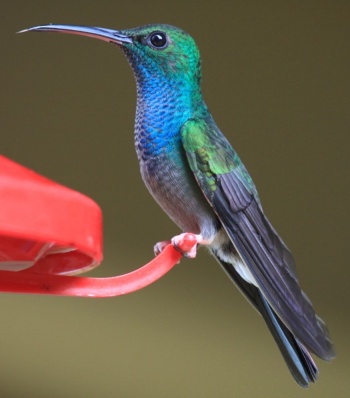Alternative name: Red-footed Plumeleteer
- Chalybura urochrysia
Identification
11cm (4.25") long and weighs 6g (female) or 7g (male)
Male: bronze-green upperparts, glittering green underparts, a dusky or white lower belly and a bronzed or purple-black tail depending on subspecies.
Female: bronze-green upperparts, grey underparts, including the lower belly, green speckling on the flanks and grey corners to the dusky bronze tail. Both sexes have pink or red feet.
Juveniles: resemble the adult, but have buff feather tips to the head, neck and rump feathers.
Variation
The Costa Rica subspecies, known as the Red-footed Plumeleteer (C. u. melanorrhoa) has a black, not bronze, tail. It was once thought to be a separate species, but in extreme western Panama it hybridizes with the Bronze-tailed Plumeleteer (C. u. isaurae). The two southern subspecies in addition differs by having the crissum area pale grey to white, considerably paler than the rest of the underside.
Distribution
Central and South America
Central America: Honduras, Nicaragua, Costa Rica, Panama
South America: Colombia, Ecuador
Taxonomy
Subspecies[1]
There are 3 supspecies:
- C. u. melanorrhoa:
- Caribbean slope of Nicaragua and Costa Rica
- C. u. isaurae:
- C. u. urochrysia:
An additional subspecies incognita is usually considered invalid[2]
Habitat
Forests, but has a preference for edges, gaps and second growth. It occurs in the Caribbean lowlands, typically up to an elevation of 700 m.
Behaviour
This hummingbird is aggressive, territorial, and usually dominant. The male will defend large clumps of Heliconia and other large flowers.
Vocalisation
Has a high metallic chip call, and the male’s song is a soft ter-pleeleeleelee ter-pleeleeleelee ter-pleeleeleelee ter-pleee.
References
- Clements, JF. 2009. The Clements Checklist of Birds of the World. 6th ed., with updates to December 2009. Ithaca: Cornell Univ. Press. ISBN 978-0801445019.
- Avibase
Recommended Citation
- BirdForum Opus contributors. (2024) Bronze-tailed Plumeleteer. In: BirdForum, the forum for wild birds and birding. Retrieved 25 April 2024 from https://www.birdforum.net/opus/Bronze-tailed_Plumeleteer
External Links
GSearch checked for 2020 platform.1






